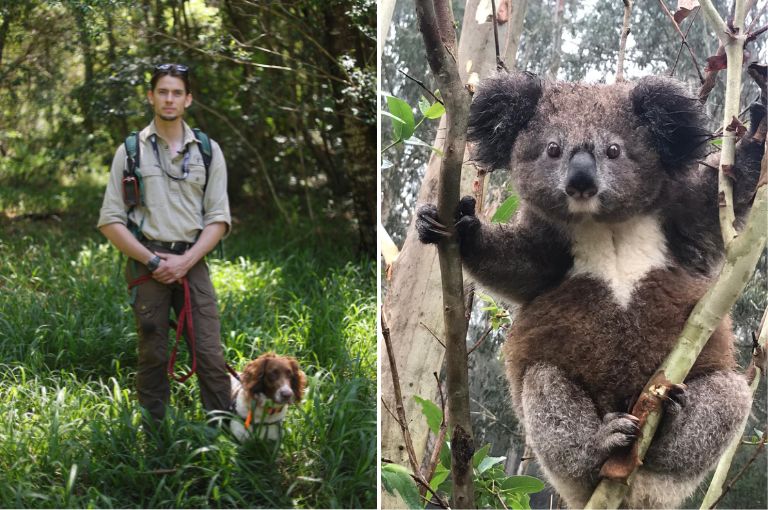
A poo-sniffing English springer spaniel named Max has struck gold – identifying a new group of koalas inland of Coffs Harbour that appear to be chlamydia free and genetically different to the rest of the koala population.
Chlamydia is one of the leading causes of the catastrophic decline in koala numbers and populations free of the disease are rare.
Surveys by Max and the team from Canines for Wildlife have also shown the broader koala population in Coffs Harbour and Bellingen has low levels of chlamydia and high genetic diversity.
The surveys identified close genetic relationships between individuals along habitat corridors, emphasising the importance of connected habitat for gene flow and a healthy genetic population.
The results have conservationists celebrating and calling for a halt to logging in state forests that contain vital koala food and habitat trees.
Canines for Wildlife were recruited to survey for koalas across 115 sites in the Coffs Harbour and Bellingen areas, ranging from coastal regions to the Dorrigo Plateau nearly 1,000 metres above sea level.
Max is trained to sniff out koala scats, which can be tested to determine the sex, health and genetic diversity of koalas.
A total of 109 scat samples were collected in 2022-2023 and sent for genetic testing at University of the Sunshine Coast – and the results are surprising and encouraging.
Testing showed there is some genetic differentiation between a group of 10 koalas on private properties at Fernbrook and those elsewhere on the Dorrigo Plateau. The Fernbrook koalas also appear to be chlamydia free.

“For a koala researcher this is such an exciting result,” said Lynn Baker from Canines for Wildlife.
“We knew the koalas at Fernbrook looked different. They are a lot furrier and darker in colour than their compatriots on the coast. They look like cold weather koalas.
“But if this is a genetically different and chlamydia-free group then it’s important that they are protected. There are not many areas left in NSW that have distinct groups of chlamydia-free koalas.
“The burning question is are these koalas isolated to the habitat on these properties or are they connected to other chlamydia-free koalas that we haven’t sampled yet?”
Canines for Wildlife is hoping to do further surveys in the areas surrounding Fernbrook to help answer this question.

The surveys to date were organised by the Jaliigirr Biodiversity Alliance with funding from a range of partners including the Great Eastern Ranges (GER) and WWF-Australia, who are working together on the Cores, Corridors and Koalas project to support koalas and other forest-dependent wildlife.
“We wanted to survey around Dorrigo because we believed it could be a hotspot for koalas,” said Justin Couper, GER project lead from the Jaliigirr Biodiversity Alliance.
“Most of the previous koala surveys have focused on the hinterland and coastal areas of Coffs, so we know very little about what is happening with koalas on the plateau, particularly since the 2019-2020 bushfires.”
While the results from Dorrigo are exciting, the scat surveys also brought good news on the wider koala population in Coffs Harbour and Bellingen.
Genetic testing of 90 koalas shows a healthy population with high genetic diversity.
They also have comparatively low levels of chlamydia, with just 32.9% showing signs of infection, while in other locations in NSW infection rates can be as high as 100%.
However, many of these high-value koalas are in danger because they live in or move through Pine Creek, Tuckers Nob and Tarkeeth State Forests – habitat currently being logged by the state-owned Forestry Corporation.
This includes areas earmarked to form part of the Great Koala National Park.

WWF-Australia conservation scientist Dr Stuart Blanch said it was senseless to allow logging to threaten this koala population before the Great Koala National Park is created.
“These surveys provide a picture of a robust, genetically healthy koala population, but that will change very quickly if we allow logging to knock down food trees and sever vital habitat corridors,” said Dr Blanch.
“The NSW Government should halt logging within the proposed national park and engage in sector wide transition planning towards sustainable timber plantations.”
“The community-led efforts being supported through projects such as Cores, Corridors and Koalas are already providing substantial benefits for our endangered koalas by restoring and reconnecting patches of core forest habitat,” added Gary Howling, CEO of Great Eastern Ranges.
“Without this crucial survey we could easily have lost this koala population without ever knowing how critically important it is. Now the government has the chance to help bolster this genetically diverse koala population’s survival by quickly protecting the remaining habitat in the region before it is gone for good.”
Click here to view Canine for Wildlife’s full survey report.



 Media release
Media release